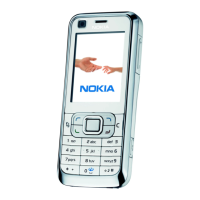
Do you have a question about the Nokia 6120c and is the answer not in the manual?
| Display Type | TFT, 16M colors |
|---|---|
| Resolution | 240 x 320 pixels (~200 ppi pixel density) |
| Operating System | Symbian OS 9.2, Series 60 v3.1 UI |
| CPU | 369 MHz ARM 11 |
| Internal Memory | 35 MB |
| RAM | 64 MB |
| Main Camera | 2 MP |
| Selfie Camera | No |
| Battery | Removable Li-Ion 890 mAh battery (BL-5B) |
| Weight | 89 g (3.14 oz) |
| Status | Discontinued |
| Network | GSM / HSPA |
| 2G bands | GSM 850 / 900 / 1800 / 1900 |
| 3G bands | HSDPA 850 / 2100 |
| Speed | HSPA 3.6/0.384 Mbps |
| GPRS | Class 32 |
| EDGE | Class 32 |
| SIM | Mini-SIM |
| Pixel density | ~200 ppi |
| Alert types | Vibration; Downloadable polyphonic, MP3 ringtones |
| Loudspeaker | Yes |
| 3.5mm jack | No |
| WLAN | No |
| Bluetooth | 2.0, A2DP |
| GPS | No |
| Radio | Stereo FM radio |
| Messaging | SMS, MMS, Email, Instant Messaging |
| Browser | WAP 2.0/xHTML, HTML |
| Games | Yes + downloadable |
| Java | Yes, MIDP 2.0 |
| Stand-by | Up to 230 h |
| Talk time | Up to 3 h 30 min |
| Display Size | 2.0 inches |
| Dimensions | 105 x 46 x 15 mm (4.13 x 1.81 x 0.59 in) |
| Announced | 2007 |
| Card slot | microSD |
| USB | miniUSB |
| Colors | Black, Pink, Blue |
General safety instructions for device usage, including road safety, interference, and device operation.
How to access help resources and Nokia's support channels for the device.
Step-by-step guide for installing the SIM card and battery into the phone.
Instructions for inserting, removing, and handling microSD memory cards safely.
Explanation of phone keys, parts, standby mode, and interface navigation.
Managing lock codes, PIN, PUK, and other security-related access codes.
Guide to making voice calls, using call mailbox, and speed dialing.
Instructions for making video calls and sharing video during calls.
How to use traditional, predictive text, and other text entry methods.
Composing, sending messages, and configuring e-mail settings.
How to add, edit, organize contacts, and create contact groups.
Saving, organizing media files, and using the music player.
Using GPS for location tracking, navigation, and finding ways.
Accessing websites, managing bookmarks, and connection security.
Customizing phone appearance with themes and managing profiles.
Configuring general phone settings, language, and security features.
Browsing files, managing memory, and formatting the memory card.
Copying and synchronizing data, and using Bluetooth connections.
Using the real-time voice communication service for group calls.
Proper battery usage, safety warnings, and authenticity verification.
General maintenance, cleaning, and additional safety precautions.